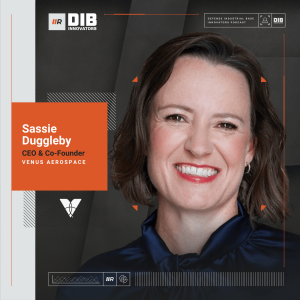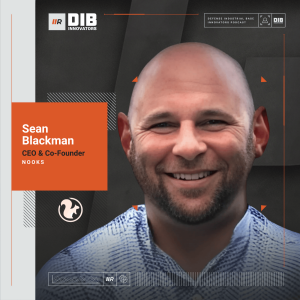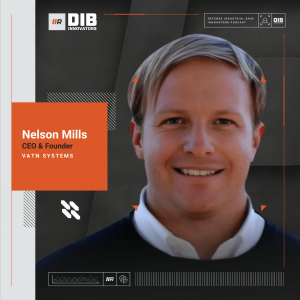DIB Innovators
The DIB Innovators podcast celebrates the brilliant minds behind innovation within the Defense Industrial Base. In each episode, host and co-founder of RADICL, David Graff will speak with DIB leaders who are driving technological advancements, championing our nation’s security, and shaping the future of defense technology. Brought to you by RADICL — Cybersecurity-as-a-Service purpose-built for small and mid-sized businesses in the Defense Industrial Base. Starting your CMMC journey? RADICL guides and accelerates your compliance—while reducing ransomware and other cyber risks—with a transparent, turn-key solution. www.radicl.com/cmmc_solved
Episodes

Thursday Jul 03, 2025
Thursday Jul 03, 2025
Defense contractors assume they understand CMMC assessments, but Matt Bruggeman, Director of GTM Federal at A-LIGN, has a harsh reality check for them: organizations consistently arrive for certification without basic documentation like authorization boundaries or data flow diagrams. The gap between CMMC perception and assessment reality is creating a compliance crisis, he tells Dave.
A-LIGN operates as a top-3 FedRAMP assessor and C3PAO, giving Matt unique visibility into federal compliance across multiple frameworks. His unconventional background combining electrical engineering from Wright-Patterson Air Force Base with professional improv comedy shaped his approach to explaining complex technical requirements through clear communication.
Topics discussed:
The assessment methodology uses NIST 800-171A that evaluates 320 assessment objectives rather than just 110 controls, requiring organizations to prove compliance across significantly more granular requirements.
External service provider scope issues that consistently trip up organizations during assessments, particularly around MSP, MSSP, and cloud service relationships that require FedRAMP authorization or equivalent.
C3PAO backlog management and timing strategies, with smaller assessors facing 3-9 month delays while larger firms like A-LIGN maintain shorter timelines through strategic CCA and CCP resource investments.
The three-bucket cost structure of CMMC compliance covering infrastructure changes, readiness process management, and assessment fees ranging from $40,000-$80,000 depending on scope complexity.
Phase 1 documentation review failures where organizations arrive without basic elements like system security plans, authorization boundaries, or data flow diagrams for CUI handling.
Readiness partner selection criteria and the risks of attempting internal-only compliance approaches that result in failed assessments and doubled costs for remediation.
The relationship between compliance frameworks and actual security posture, including how feedback during public comment periods can influence framework development and practical implementation.
FedRAMP equivalency requirements for cloud service providers handling CUI, including the December 2023 DoD memo defining the single pathway through 3PAO assessment against FedRAMP moderate baseline.
Early C3PAO engagement advantages including assessment planning coordination, partner network efficiencies, and pricing benefits for organizations working with vetted readiness partners.

Thursday Jun 26, 2025
Thursday Jun 26, 2025
Venus Aerospace achieved the first flight of a high-thrust rotating detonation rocket engine, proving that decades of theoretical research can translate into breakthrough propulsion technology. Sassie Duggleby, CEO & Co-founder, tells Dave about conducting eight engine tests per day while maintaining manufacturing, mission control, and testing in the same facility compressed development timelines from decades into four years.
The breakthrough enables rockets to operate with 67% propellant instead of the industry standard 90%, creating massive payload advantages for defense applications. Sassie shares their strategic pivot from commercial hypersonic travel to defense applications as geopolitical realities shifted, and how combining detonation technology with ramjet systems creates single engines capable of accelerating from takeoff to Mach 5 with no moving parts. She also addresses advanced fundraising strategies for deep tech companies and regulatory challenges including FAA limitations that forced them to throttle capable systems during testing.
Topics discussed:
The technical breakthrough of rotating detonation rocket engines that achieve supersonic combustion while reducing propellant requirements from 90% to 67% of total system weight.
Rapid iteration methodologies that enable eight engine tests per day through integrated manufacturing, mission control, and testing facilities at Houston Spaceport.
Proprietary thermal management solutions that prevent detonation engines from melting during sustained operation at supersonic combustion temperatures.
Strategic pivoting from commercial hypersonic travel applications to defense programs including missiles, drones, and orbital transfer vehicles as market conditions evolved.
Combined detonation-ramjet engine systems that enable single powerplants to accelerate from takeoff to Mach 5 with no moving parts.
Deep tech fundraising strategies for transitioning from R&D-focused companies to production-scale operations while maintaining investor confidence during market downturns.
Regulatory navigation challenges in hypersonic flight testing, including FAA speed limitations and the development of commercial test ranges for advanced propulsion systems.
The formation and operation of support networks for female aerospace founders in an industry where women represent only 10-11% of the workforce.
Scaling challenges for breakthrough propulsion technologies, including IP protection strategies and the transition from academic research to commercial applications.

Thursday Jun 19, 2025
Thursday Jun 19, 2025
America's defense innovation pipeline has a massive bottleneck that most people don't even realize exists: the infrastructure access problem that prevents our best technology companies and cleared talent from working on classified programs. Sean Blackman, Co-founder & CEO at Nooks, experienced this firsthand as a Navy F-18 pilot trying to get non-traditional companies onto classified contracts, only to discover the catch-22 that has plagued defense innovation for decades. His solution is treating classified infrastructure like cloud computing rather than requiring bespoke facilities
Sean's journey from the cockpit to Meta's anti-misinformation team to highlights why traditional approaches to classified work infrastructure are failing at scale. With 5 million Americans now holding security clearances compared to hundreds of thousands decades ago, the old model of one company, one contract, one SCIF simply doesn't work anymore. The conversation with Dave explores how Nooks is building a network of shared classified facilities that companies can access for $500 per user per month — less than the cost of flying across the country to use traditional SCIFs.
Topics discussed:
The fundamental chicken-and-egg problem preventing non-traditional defense companies from accessing classified work due to SCIF requirements versus contract prerequisites.
How the shift from hundreds of thousands to 5 million Americans with security clearances has broken the traditional bespoke infrastructure model that worked for smaller cleared populations.
The strategic application of fractional biotech lab models to classified infrastructure, creating shared facilities that accelerate innovation through increased access and reduced barriers.
Why 60-70% of existing SCIFs face obsolescence under new government standards, creating an unprecedented recapitalization crisis across the defense and intelligence community.
The operational complexity of integrating over 1,000 different classified networks across agencies that historically avoided collaboration by building separate systems.
The dual-use business model that serves both government agencies facing return-to-office challenges and private companies needing classified access without bespoke facility investments.
Mobile SCIF deployment capabilities that can establish classified work environments anywhere in the United States within eight hours, fundamentally changing geographic constraints.
The security advantages of consolidating classified work into professionally managed facilities with dedicated security focus versus thousands of companies interpreting security policy individually.
Why treating security as a revenue center rather than cost center enables investment in advanced protective technologies that exceed traditional facility capabilities.

Thursday Jun 12, 2025
Thursday Jun 12, 2025
The underwater domain has become central to great power competition, yet existing autonomous underwater vehicles cost $500,000+ and require teams of specialists to operate single units. Nelson Mills, CEO & Founder of Vatn Systems, and his team have flipped this equation, building vehicles that travel 30+ knots underwater while enabling one operator to deploy hundreds of units with minimal training.
Nelson's experience as an investor proved invaluable not just for fundraising connections, but for understanding what investors seek in defense companies and how to structure deals effectively. His focus on user experience draws from consumer technology principles, recognizing that ease of use and intuitive operation create force multiplication effects that traditional defense contractors often overlook.
Topics discussed:
The three-pillar defense sales framework encompassing operator advocacy, program office relationships, and congressional support.
Patent-pending modularity architecture that enables mass production of 2,000+ units annually while supporting diverse payload configurations.
Strategic focus decisions between dual-use applications versus concentrated government market penetration, including resource allocation considerations.
In-house navigation system development to overcome cost constraints of existing high-end solutions while maintaining tactical utility and performance standards.
User experience design principles applied to defense technology, emphasizing intuitive operation and minimal training requirements for force multiplication effects.
Manufacturing digitization through Palantir partnership to identify bottlenecks, supply chain issues, and optimization opportunities in real-time production environments.
Congressional engagement strategies including lobbyist utilization, NDAA language development, and appropriations advocacy as essential components of defense market access.
Valley of death navigation through transitional funding programs while layering products at different technology readiness levels.
Autonomous decision-making capabilities including obstacle avoidance, target recognition through sonar, and mission adaptation without constant human oversight.
Commercial applications in offshore wind, cable monitoring, and energy sector operations as adjacent markets requiring minimal engineering modifications to core vehicle platforms.

Thursday Jun 05, 2025
Thursday Jun 05, 2025
The defense industrial base faces a manufacturing crisis that goes far deeper than workforce shortages, and John Albers, President/CEO of Albers Aerospace has positioned his company at the center of solving it. He grew Albers Aerospace from solo systems engineering to a $10 million vertically integrated manufacturer through 12 strategic acquisitions, all funded internally without outside investment until late 2024. His approach reveals how speed, strategic diversification, and long-term thinking can build resilient defense manufacturing capabilities even as traditional approaches struggle with slow cycles and demographic challenges.
John tells Dave that he attributes his business philosophy to reading Warren Buffett's shareholder letters repeatedly after his first business venture failed. Rather than taking distributions, he focused on building company value through acquisitions that provided both capability and customer diversification. The strategy proved prescient as his company evolved from services into weapons manufacturing, now producing components for F-35, F-16, and multiple missile programs while maintaining aircraft integration capabilities through recent acquisitions.
Topics discussed:
Strategic acquisition approach that prioritizes customer value over traditional ROI calculations, resulting in 12 company purchases funded through internal cash flow and moderate leverage rather than external investment.
Advanced manufacturing integration combining robotics, digital engineering, and traditional machining to maintain competitiveness while addressing skilled workforce shortages through 21-hour automated operations.
Three-vertical business model balancing industrial manufacturing, defense services for predictable cash flow, and innovation incubation to develop scalable solutions across the organization.
Defense industrial base classification challenges where companies face punitive size restrictions that prevent natural growth from small to large contractor status, limiting competition and industrial capacity.
Workforce development crisis stemming from elimination of vocational training programs, creating artificial scarcity in trades that will drive wage premiums and entrepreneurial opportunities for skilled workers.
Leadership philosophy adaptation from military servant leadership principles to business contexts, emphasizing individual thinking and leadership at every organizational level rather than hierarchical command structures.
Weapons manufacturing diversification strategy touching major programs through specialized components rather than platform-specific focus, providing resilience against program cancellations and budget fluctuations.
Veteran transition challenges requiring complete professional identity reconstruction rather than translating military experience directly into civilian business contexts, emphasizing humility and continuous learning.
Manufacturing cycle management addressing the extended timelines from quoting through material procurement to delivery, requiring sophisticated financial planning and pricing strategies to maintain profitability.
Customer-centric problem solving approach that prioritizes understanding client pain points over presenting predetermined solutions, leveraging acquisition experience to maintain customer perspective throughout business growth.

Thursday May 29, 2025
Thursday May 29, 2025
The Ukrainian conflict revealed a stark reality that should light a fire under American defense planners: modern warfare consumes weapons at rates that would exhaust our entire arsenal in months, not years. In his conversation with Dave on the latest DIB Innovators, Kunal Mehra, President of Scientific Systems, brings a unique perspective to solving this crisis, shaped by his family's experience fleeing partition-era India and his father's determination to strengthen democratic nations through advanced technology.
Kunal argues that our addiction to "exquisite systems" has created a fundamental mismatch between 20th century military thinking and 21st century threats. The solution requires abandoning the hardware-defined military model in favor of software-defined capabilities that can rapidly turn commercial platforms into effective weapon systems. Scientific Systems' CMA platform demonstrates this approach across three layers: individual platform navigation without GPS, collaborative swarm coordination, and cross-domain orchestration. This architecture has proven adaptable from sea floor to space, enabling autonomous kill chain closure from detection to engagement.
Topics discussed:
The affordable mass imperative and why exquisite systems fail against distributed threats across vast Pacific distances with adversaries achieving numerical superiority.
CMA software architecture's three-layer approach: platform-level navigation without GPS, swarm collaboration for complex missions, and cross-domain orchestration for autonomous kill chains.
How underwater development environments naturally replicate contested battlefield conditions, forcing edge-based AI decision making with limited communication and sensor data.
The acquisition system evolution from winner-take-all programs to separated software/hardware procurement with constant competition cycles every six months.
Strategic approaches to crossing the valley of death through end-user demonstration, congressional relationships, and clear value propositions to prime contractors.
Why the defense industrial base needs billion-dollar software companies with developers embedded in operational environments for real-time capability iteration.
The capital allocation shift as venture firms recognize defense market disruption opportunities beyond traditional West Coast unicorns.
Project Replicator and DIU methodologies for rapid capability fielding using OTAs and special authorities to bypass traditional acquisition timelines.
Dual-use technology applications in urban air mobility, industrial automation, and re-industrialization efforts requiring edge-based autonomy capabilities.

Thursday May 22, 2025
Thursday May 22, 2025
When America's adversaries can outbuild us in ships, what's our strategic advantage? Paul Lwin, CEO & Co-founder of HAVOCai, shares how his company is revolutionizing maritime operations by creating affordable autonomous vessels that can operate in swarms. As a Myanmar refugee who first saw American uniforms during his evacuation at age 10, Paul brings a unique perspective to defense innovation, combining his military experience with Silicon Valley approaches to solving national security challenges.
On this episode of DIB Innovators, Paul tells Dave about how, in just 17 months, HAVOCai has delivered 31 autonomous vessels to the Department of Defense, generated $3 million in revenue without government R&D funding, and demonstrated capabilities that outpace competitors who've been in the space for over a decade. Their conversation highlights how defense startups are creating asymmetric advantages for America by leveraging commercial manufacturing capacity, off-the-shelf components, and sophisticated software to transform maritime operations in the Pacific.
Topics discussed:
Creating a strategy where adversaries must spend million-dollar missiles to target $100,000 autonomous boats, creating favorable cost exchanges in conflict scenarios.
Leveraging existing American manufacturing capacity and proven commercial components rather than building expensive custom solutions from scratch.
Developing software that enables small teams to control dozens of vessels simultaneously, creating true swarm capabilities rather than the 90% remote-controlled systems offered by competitors.
Abstracting away boat building to focus engineering resources on sophisticated algorithms that enable autonomous decision-making and collaborative behavior.
Implementing theatre-level, sector-level, and unit-level command structures that mirror traditional military organization while integrating autonomous capabilities.
Using autonomous vessels to resupply isolated units on island chains when traditional air logistics would be vulnerable to enemy fire.
Building resilience into autonomous systems that can continue missions for days or months without human input when adversaries jam communications.
Integrating COLREGS compliance for commercial environments while maintaining tactical capabilities for conflict scenarios.
Leveraging the unprecedented convergence of government acquisition reform, venture capital interest in defense, and Silicon Valley technical talent to accelerate innovation.
Creating logistics and manufacturing processes capable of delivering up to 10,000 vessels annually when required for operational deployment.

Thursday May 15, 2025
Thursday May 15, 2025
When Rhys Andersen, Founder & CEO at Method MFG, moved to Texas with an architecture degree, he never imagined he'd end up machining components for spacesuits and rockets. Yet his journey from welding to founding his company exemplifies the untapped potential in American manufacturing. By combining cutting-edge technology with a focus on upskilling his entire team, Rhys has created a manufacturing environment that more closely resembles a tech company than a traditional machine shop — with white walls, white floors, and sophisticated software driving everything from quoting to production.
Rhys also shares with Dave his practical experience building a bootstrapped manufacturing company servicing aerospace and defense clients, including his counterintuitive approach to workforce development and the technologies revolutionizing production. His insights demonstrate why manufacturing's image problem is holding back America's industrial base, and how rebranding machining as the tech profession it truly is could help solve critical workforce shortages.
Topics discussed:
Bootstrapping a capital-intensive manufacturing business by purchasing used equipment at a fraction of the cost for new pieces, while supplementing income through with other work to fund the company's early growth.
The transformation of machining into a tech profession where white-collar programmers operate sophisticated 5-axis equipment and automation cells rather than traditional machine operators.
Creating comprehensive cross-training programs to eliminate single points of failure by ensuring every machinist can program and operate the company's most sophisticated equipment.
Leveraging technology as a multiplier through automation cells with robots that can change their own end effectors to handle everything from small vises to 900 kg pallets for unattended overnight production.
The critical role of process documentation using iPads in the shop to capture setup photos and detailed notes, creating an institutional knowledge repository that prevents "reinventing the wheel" with repeat jobs.
Strategic vertical integration decisions like building an in-house anodizing line to control quality and turnaround times for quick-turn aerospace components rather than relying on external vendors.
Managing complex stress patterns in large aerospace components by creating strategic relief cuts and adapting clamping approaches to ensure finished parts maintain tolerance despite internal material stresses.
The potential of AI-driven programming to automate routine aspects of CAM while allowing machinists to focus on more creative problem-solving and complex machining strategies.
Rebranding manufacturing careers through educational partnerships showing students that modern machining involves sophisticated software, 5-axis programming, and automation rather than traditional manual labor.

Thursday May 08, 2025
Thursday May 08, 2025
President & COO Matthew Malone's journey from solving locomotive failures in Indonesia to leading Graham Manufacturing offers rare insight into how technical expertise transforms into business leadership. In this episode of DIB Innovators, Matthew tells Dave how Graham bridges the innovation gap between rapid-iteration space technology and methodical defense requirements while manufacturing critical components for Columbia-class submarines and Ford-class carriers. His perspective challenges conventional thinking about workforce development, supply chain management, and the often-overlooked IT infrastructure that enables entire organizations to function effectively.
Topics discussed:
How technical problem-solving skills translate directly to business strategy, with Matthew's background in mechanical engineering enabling both relationship-building and physics-based risk management.
Strategies for convincing rapid-iteration innovators to work within methodical defense frameworks while using advanced computational fluid dynamics to redesign legacy systems.
How connecting 3D design environments directly to production eliminates paper-based processes, enabling much faster concept-to-prototype cycles and more efficient system architecture design.
Implementing apprenticeship programs for machinist development while restructuring teams around complementary strengths rather than searching for individual employees who can do it all.
Treating suppliers as team members by extending resources, deploying manufacturing engineers to improve their processes, and working with government agencies to secure funding for dual-sourcing critical components.
Managing supply chain risks around rare earth metals for electrification and advanced power electronics, where component differences between vendors can be the difference between product success and failure.
The methodical process of demonstrating value to defense customers, from execution within existing structures to proposing improvements that deliver tangible benefits in cost, lead time, or obsolescence management.
Why many leaders focus exclusively on domain-specific capabilities while neglecting the critical systems that allow hundreds of employees to collaborate effectively across the organization.

Thursday May 01, 2025
Thursday May 01, 2025
The race to protect America's orbital assets is accelerating, and Agile Space Industries is providing the engines needed for rapid spacecraft maneuverability. In this episode of DIB Innovators, CEO Chris Pearson walks Dave through how decades-old chemical propulsion technology is finding new relevance as Space Force openly prepares for potential conflict in space. Through vertical integration combining additive manufacturing and in-house test facilities, Agile has achieved 50% annual growth, turning a garage operation into a company with $42 million in backlog.
Chris also shares his journey from UK space engineer to Colorado-based entrepreneur, building multiple successful companies before taking the helm at Agile. His insights on scaling hardware businesses through strategic funding combinations — from non-dilutive SBIR grants to strategic investments from defense primes — provide a masterclass in defense technology commercialization. As Agile expands with a new facility in Tulsa, Chris also offers candid perspectives on managing the cultural transition from innovative startup to production-focused manufacturer while maintaining the speed that gives them their edge in the market.
Topics discussed:
How national security space requirements have shifted from satellite deployment to preparing for potential orbital conflict, creating demand for rapid-maneuverability propulsion.
The technical limitations of electric propulsion for military applications, with chemical propulsion providing the immediate thrust needed for threat response and evasive maneuvers.
Leveraging additive manufacturing to condense propulsion system development cycles from months to days by printing complex. geometries impossible with traditional subtractive manufacturing
Creating vertical integration through in-house test facilities that eliminate industry bottlenecks and enable rapid iteration between design and qualification testing.
Strategic capital raising approach combining non-dilutive funding, strategic investment, and commercial revenue to maintain favorable terms.
Balancing the triple funding strategy of government investment, commercial partner funding, and internal R&D to accelerate commercialization while maintaining IP ownership.
Managing organizational evolution from garage operation to volume manufacturer while retaining innovation speed and preventing analysis paralysis.
Building transparent customer relationships around risk management for first-of-kind space technologies, rather than promising unrealistic certainty in performance.
Diversifying from component supply to full propulsion systems and launch logistics services to capture more of the rapidly expanding space operations value chain.


